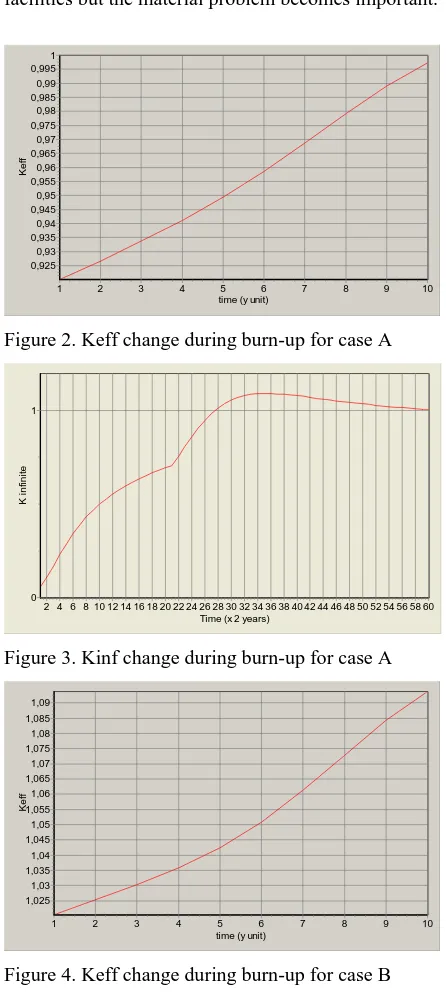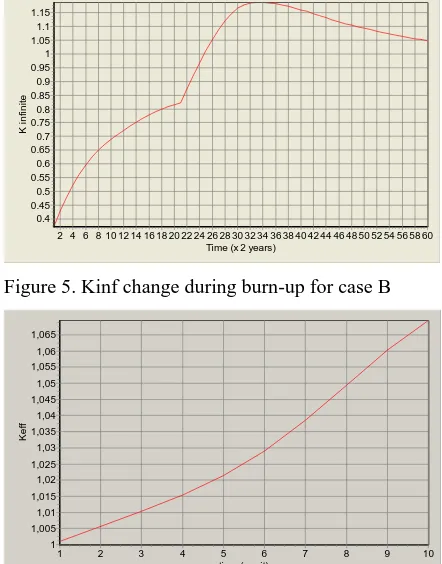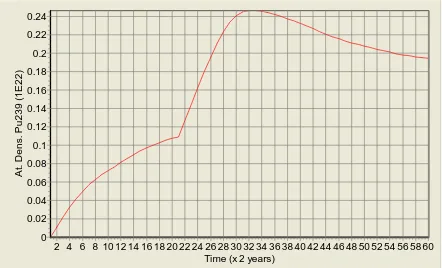Indonesian Journal of Physics
Vol 20 No. 1, January 2009
17
Feasibility Design Study of Long Life BWR with Natural Uranium/Thorium
as Fuel Cycle Input
Zaki Su'ud1), Rijal Kurniadi1), Rida SNM2), and Zuhair3)
1)
Nuclear and Biophysics Research Division, Faculy of Mathematics and Natural Sciences,
Bandung Institute of Technology, Jl. Ganesha 10, Bandung, Indonesia
2)
Doctoral Student, Dept. Nuclear Engineering, Kyushu University, Japan
3)
PTRKN BATAN Kompleks Puspitek Serpong e-mail: [email protected]
Abstract
Feasibility design study of Long Life BWR with natural uranium/thorium as fuel cycle input has been performed. The reactor core is divided into 6 equal regions in radial direction. The fresh fuel is first loaded into the most outer region then shifted to the center of the core, and from there shifted to the nearby region in the outward direction. Nitride fuel is employed in the core to get better criticality and conversion/breeding ratio. The results show that uranium fuel combined with low moderating ratio environment is superior to make the system critical.
Keywords: Long life, BWR, Uranium cycle, Thorium cycle, Criticality
1. Introduction
The utilization of natural uranium and thorium is important to keep the optimal nuclear energy resources. On the other hand nuclear fuel enrichment and nuclear fuel reprocessing which is needed to use nuclear energy using current technology are very sensitive issues related to the nuclear non-proliferation in the world especially when it is carried out in the developing countries. Long life reactor without on-site refuelling based on uranium or thorium fuels are an example of method to more efficently utilize these fuels1-11).
In the previous works, liquid metal cooled long life fast reactor which can be continuously operated by only supplying natural uranium without fuel enrichment plant or fuel reprocessing plant has been
confirmed possible12-15). Combined with high
neutronic and safety performance such reactors have good prospects in the future. However the dominant current commercial Nuclear Power Plant (NPP) are based on water cooled system.
Therefore, in this paper feasibility design study of long life tight lattice BWR reactors which can be continuously operated by only supplying natural uranium without fuel enrichment plant or fuel reprocessing plant is investigated. Using such type of NPPs optimum nuclear energy utilization including in developing countries can be easily conducted without the problem of nuclear proliferation.
2. Design Concept and Calculation Method
In this study the following design concept are adopted. The active core is subdivided into 6 sub region in radial direction (see Figure 1) and reflector is put in the the most outer region. The fresh fuel is initially put in region 5, then shifted to region 6, and after that shifted to regions 1, 2, 3 and then 4. Region 7 is filled with reflector (mainly water). Nitride fuel is
employed to provide high density fertile and fissile material in the core.
Reg. 1 Third shift
Reg. 2 Fourth shift
Reg. 3 Fifth shift
Reg. 4 Sixth shift
Reg. 5 First shift
Reg. 6 Second shift
Reg. 7 Reflector
Figure 1. Shuffling scheme
The calculation method can be described as follows. The calculation is started by guessing power density in each region, then cell burn-up calculation is performed using SRAC code system. Then multi-group diffusion calculation is performed using FIITB-CH1 code and the resulted power density distribution is taken as feedback for cell calculations. The iteration is performed till convergence condition is reached12-14).
3. Calculation Results and Discussion
18 IJP Vol. 19 No. 4, 2008
Table 1. General Reactor Parameter
Parameter Value/description
Power (MWth) 2200-3500 Number of equal volume region
in core
6
Sub cycle length (years) 10 Fuel type Nitride (UN-PuN) Fuel volume fraction 60% Cladding vol. fraction 12.5% Coolant volume fraction 27.5% Fuel diameter 1.2 cm Coolant type H2O
Radial width of first (central) region
70 cm
Axial reflector width 70 cm Radial reflector width 70 cm Active Core Radius 171.5 cm
Table 2 Specific parameter for each core type
Core Type
Power MWt
Active Core Height
(cm)
Void Fraction
(%)
Note
A 2200 200 99 Thorium cycle B 3000 250 98 Uranium cycle C 3000 250 95 Uranium cycle D 3200 250 97.5 Uranium cycle
Figures 4 and 5 show Keff and Kinf pattern change during burn-up for case B (U cycle with very high void fraction). It is shown that the system is critical with enough margin of Keff, and during burn-up the value of Keff continuously increases. The kinf value is more than 1.0 for more than half of the burn-up period. The average burn-burn-up level of the fuel in this case is nearly 370000MWd/tonHM.
Figures 6 and 7 show Keff and Kinf pattern change during burn-up for case C (U cycle with 95% void fraction). It is shown that the system is critical with small margin of Keff, and during burn-up the value of Keff also continuously increases. The kinf value is more than 1.0 for more than half of the burn-up period but the maximum value is still lower than that of case B. The kinf value is more than 1.0 for more than half of the burn-up period. The average burn-up level of the fuel in this case is nearly 365000MWd/ton HM.
Figures 8 and 9 show Keff and Kinf pattern change during burn-up for case D (U cycle with 97.5% void fraction). It is shown that the system is critical with enough margin of Keff, and during burn-up the value of Keff also continuously increases. The kinf value is more than 1.0 for more than half of the burn-up period but the maximum value is still lower than that of case B. The kinf value is more than 1.0 for more than half of the burn-up period which is slightly larger than that of case B but higher than that of case C. The average burn-up level of the fuel in this case is nearly 400000MWd/ton HM as shown in Figure 10.
Figure 11 shows radial power distribution at the beginning of life of case D. It is shown that the
core becomes very active just after entering region 2 (after half of overall burn-up process). Figure 12 shows conversion ratio change during burn-up. As burn-up proceed the conversion ratio continuously decreases due to decreasing number of fissile material and increasing number of fissile material especially at the first half of burn-up period. This is shown in Figures 13-14.
From the above results it can be seen that the neutron spectrum has important role in this system. Higher void ratio means harder spectrum that give higher conversion/breeding ratio so that natural uranium/thorium can be transformed into fissile material more effectively.
The burn-up level up to 400000MWd/ton or about 40%HM show that the natural uranium/thorium fuel can be utilized optimally without fuel cycle facilities but the material problem becomes important.
time (y unit)
10 9 8 7 6 5 4 3 2 1
Ke
ff
1 0,995 0,99 0,985 0,98 0,975 0,97 0,965 0,96 0,955 0,95 0,945 0,94 0,935 0,93 0,925
Figure 2. Keff change during burn-up for case A
Time (x 2 years)
60 58 56 54 52 50 48 46 44 42 40 38 36 34 32 30 28 26 24 22 20 18 16 14 12 10 8 6 4 2
K
i
n
fi
n
ite
1
0
Figure 3. Kinf change during burn-up for case A
time (y unit)
10 9 8 7 6 5 4 3 2 1
Ke
ff
1,09 1,085 1,08 1,075 1,07 1,065 1,06 1,055 1,05 1,045 1,04 1,035 1,03 1,025
IJP Vol. 19 No. 4, 2008 19
Figure 5. Kinf change during burn-up for case B
time (y unit)
10
Figure 6. Keff change during burn-up for case C
Time (x 2 years)
Figure 7. Kinf change during burn-up for case C
time (y unit)
10
Figure 8. Keff change during burn-up for case D
Time (x 2 years)
Figure 9. Kinf change during burn-up for case D
Time (x 2 years)
Figure 10. Burn-up history for case D
Radial dist.(mesh)
38
Figure 11. Radial power density distribution at the center for case D (BOL)
20 IJP Vol. 19 No. 4, 2008
Time (x 2 years)
60 55 50 45 40 35 30 25 20 15 10 5
A
t.
D
en
s
. U
238
(
1
.0
E
24)
0.03 0.029 0.028 0.027 0.026 0.025 0.024 0.023 0.022 0.021 0.02 0.019 0.018 0.017 0.016
Figure 13 U-238 atomic density change during burn-up for case D
Time (x 2 years)
60 58 56 54 52 50 48 46 44 42 40 38 36 34 32 30 28 26 24 22 20 18 16 14 12 10 8 6 4 2
A
t.
D
ens
. P
u23
9 (
1E
22
)
0.24
0.22
0.2
0.18
0.16
0.14
0.12
0.1
0.08
0.06
0.04
0.02
0
Figure 14 Pu-239 atomic density change during burn-up for case D
Conclusion
Feasibility design study of Long Life BWR with natural uranium/thorium as fuel cycle input has been performed and the results show that uranium fuel combined with high void fraction environment is superior to make the system critical. Thorium cycle can not make the system critical under current condition. The resulted burnup level is about 350000-400000MWd/tonHM, and special material is needed.
References
1. Yuli Astuti and Zaki Su’ud, Preliminary Design
Study of 40-100MWth Small Pressurized Water Reactor Using Thorium-uranium Based Fuel, Tokyo Tech COE INES ~ Indonesia Conference, Bandung, March 2-4, 2005.
2. M. Nurul Subkhi and Zaki Su’ud, Design Study
of Small Long-Life Thorium-Uranium Fueled Pressurized Water Reactor (PWR), Tokyo Tech COE INES ~ Indonesia Conference, Bandung, March 2-4, 2005.
3. Eka Sapta Riyana and Zaki Suud, Design Study
of Thorium Cycle Based Tight Lattice Long Life BWR, Proceeding of GLOBAL 2005 Conference, October 9-13, Tsukuba 2005.
4. T. Setiadipura et al., Neutronic Design Study of
Small Long Life PWR with (Th,U) O2 fuel,
Proceeding of GLOBAL 2005 Conference, October 9-13, Tsukuba 2005.
5. Dwi Irwanto and Zaki Su’ud, Design Study of
Long Life Thorium Based PWR Using Annular Fuel Pin and Pa-231 as Burnable Poisson, Asian Physics Seminar 2005, Bandung, Indonesia, December 7-8, 2005.
6. Eka Sapta Riyana and Zaki Su’ud, Preliminary
Design Study of Thorium and Protactinium Based Fuel for Long Life BWR, Asian Physics Seminar 2005, Bandung, Indonesia, December 7-8, 2005.
7. Muh. Nurul Subkhi and Zaki Su’ud, Preliminary
Study of Small Long–Life PWR Core with Thorium Protactinium Fuelled, Asian Physics Seminar 2005, Bandung, Indonesia, December 7-8, 2005.
8. Iyos Subki et al., The Utilization of Thorium for
Long Life Small Thermal Reactors Without On-Site Refueling, Progress of Nuclear Energy, 50, p. 152-156, 2008.
9. Zaki Su’ud, Comparative Study on Safety
Performance of Nitride Fueled Lead-Bismuth Cooled Fast Reactor with Various Power Level,
Progress of Nuclear Energy, 32:3/4 pp. 571~577,
1998.
10. Zaki Su’ud, Neutronic Performance Comparation
of MOX, Nitride and Metallic fuel based 25-100 MWe Pb-Bi Cooled Long Life Fast Reactors without on site Refuelling, Progress of Nuclear
Energy, 50, p. 276-278, 2008.
11. Zaki Su’ud, Safety Performance Comparation of
MOX, Nitride and Metallic fuel Based 25-100 MWe Pb-Bi Cooled Long Life Fast Reactors without on site Refuelling, Progress of Nuclear
Energy, 50, p. 157-162, 2008.
12. Zaki Suud et al., Design Study of Long Life
Pb-Bi Cooled Fast reactors Which Need Natural Uranium as Input Fuel Cycle, IAEA RCM Meeting, Vienna 4-8 Juni 2007.
13. Rida SNM and Zaki Su’ud, Design Study of
Pb-Bi Cooled Fast Reactors Which Fuel Cycle Input is Natural Uranium, Internatinal Journal of
Nuclear Energy Science and Technology (IJNEST) 4:3, p 217-222, 2009.
14. Zaki Suud et al., Design Study of CANDLE
Scheme Based Long Life Reactors With Input Fuel Cycle is Natural Uranium, Proceeding ICANSE 2007, 13-14 November 2007, Bandung, Indonesia.
15. H. Sekimoto and A. Nagata, "CANDLE" Burnup
Regime After LWR Regime, Progress of Nuclear


